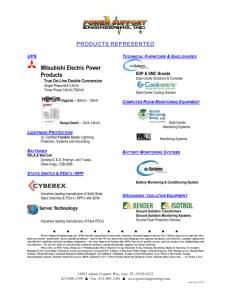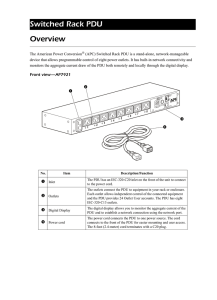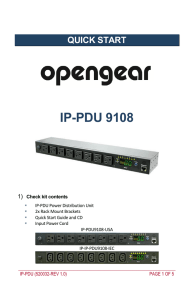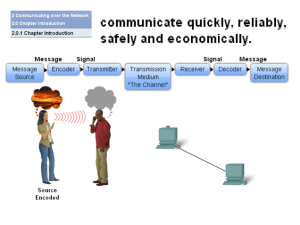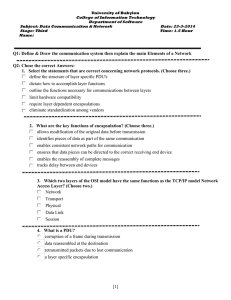Specifications - Critical Power
advertisement
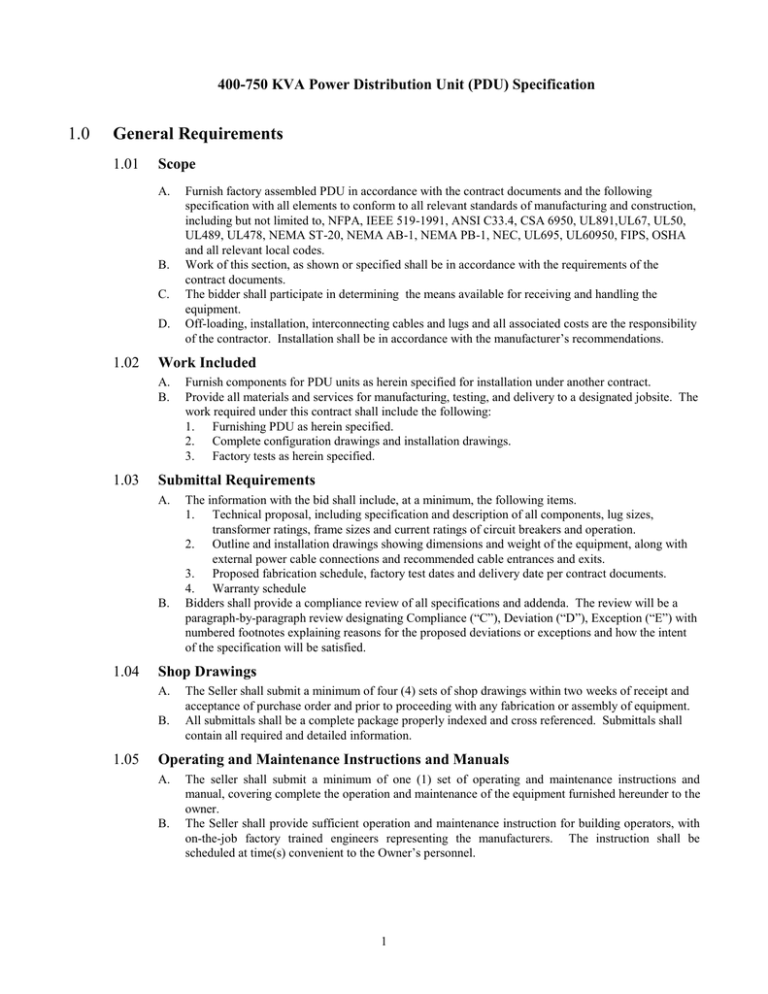
400-750 KVA Power Distribution Unit (PDU) Specification 1.0 General Requirements 1.01 Scope A. B. C. D. 1.02 Work Included A. B. 1.03 B. The information with the bid shall include, at a minimum, the following items. 1. Technical proposal, including specification and description of all components, lug sizes, transformer ratings, frame sizes and current ratings of circuit breakers and operation. 2. Outline and installation drawings showing dimensions and weight of the equipment, along with external power cable connections and recommended cable entrances and exits. 3. Proposed fabrication schedule, factory test dates and delivery date per contract documents. 4. Warranty schedule Bidders shall provide a compliance review of all specifications and addenda. The review will be a paragraph-by-paragraph review designating Compliance (“C”), Deviation (“D”), Exception (“E”) with numbered footnotes explaining reasons for the proposed deviations or exceptions and how the intent of the specification will be satisfied. Shop Drawings A. B. 1.05 Furnish components for PDU units as herein specified for installation under another contract. Provide all materials and services for manufacturing, testing, and delivery to a designated jobsite. The work required under this contract shall include the following: 1. Furnishing PDU as herein specified. 2. Complete configuration drawings and installation drawings. 3. Factory tests as herein specified. Submittal Requirements A. 1.04 Furnish factory assembled PDU in accordance with the contract documents and the following specification with all elements to conform to all relevant standards of manufacturing and construction, including but not limited to, NFPA, IEEE 519-1991, ANSI C33.4, CSA 6950, UL891,UL67, UL50, UL489, UL478, NEMA ST-20, NEMA AB-1, NEMA PB-1, NEC, UL695, UL60950, FIPS, OSHA and all relevant local codes. Work of this section, as shown or specified shall be in accordance with the requirements of the contract documents. The bidder shall participate in determining the means available for receiving and handling the equipment. Off-loading, installation, interconnecting cables and lugs and all associated costs are the responsibility of the contractor. Installation shall be in accordance with the manufacturer’s recommendations. The Seller shall submit a minimum of four (4) sets of shop drawings within two weeks of receipt and acceptance of purchase order and prior to proceeding with any fabrication or assembly of equipment. All submittals shall be a complete package properly indexed and cross referenced. Submittals shall contain all required and detailed information. Operating and Maintenance Instructions and Manuals A. B. The seller shall submit a minimum of one (1) set of operating and maintenance instructions and manual, covering complete the operation and maintenance of the equipment furnished hereunder to the owner. The Seller shall provide sufficient operation and maintenance instruction for building operators, with on-the-job factory trained engineers representing the manufacturers. The instruction shall be scheduled at time(s) convenient to the Owner’s personnel. 1 1.06 Installation A. 1.07 Guarantee A. 1.08 The PDU shall be warranted by the manufacturer to be free from defects in workmanship and material for a period of eighteen (18) months from initial shipment or one (1) year from start-up, which ever occurs first. This warranty is contingent upon having a factory authorized representative perform the start-up. Warranty shall include all costs of repair, parts, labor, travel and living expenses for the service personnel. Standards A. 2.0 Installation shall be in compliance with all the manufacturer’s recommendations and local codes. All start up and warranty troubleshooting shall be performed by the manufacturer or an authorized representative. Initial startup and site testing shall be done by the manufacturer or an authorized representative. The complete System shall be in accordance with the standards previously listed and in compliance with the applicable portions of Underwriters Laboratories UL 60950. All equipment is to be listed and labeled prior to shipment by UL, ETL or CSA. Product Specification 2.01 General A. 2.02 The Power Distribution Unit (PDU) shall be a transformation and distribution system that delivers computer grade power from a single input power source The PDU shall be custom configured and assembled in a cabinet combining a Transformation Module for voltage transformation, isolation, and/or harmonic reduction, and a Distribution Module that is configured to feed and protect specific downstream loads. The performance and operation of the PDU shall be controlled and monitored through an Operator Interface Module. Construction A. Enclosure for the PDU shall be constructed in modular configuration to NEMA Type-1 standards. The enclosure shall be primed and painted with a suitable semi-gloss enamel both inside and out. Color shall be manufacturer’s standard: IBM Pearl White (or “computer hardware off-white”). The entire system shall be housed within a cabinet with the following dimensions: 400 & 500 KVA: 81.00”H x 60.00”W x 40”D 625 & 750 KVA: 81.00”H x 66.00”W x 42”D Each PDU cabinet shall be designed for mounting on on both fixed and raised flooring. PDU must sits on its own base. B. C. D. E. F. The cabinet enclosure shall include a punchable output cable landing panel to provide ample output cable space for both immediate and future cabling requirements. All operator controls and instrumentation shall be visible through the front door. All breakers and switches shall be mounted behind closed doors to limit control access to only authorized personnel. All wiring shall be rated per the National Electric Code. The PDU shall include a computer grade single point ground in accordance with FIPS Pub 94 and the requirements of NEC. The PDU shall have Top entry/Top exit or Bottom Entry/Bottom Exit . The welded bus configuration shall ensure that all connections from the transformer bus to the output circuit breaker are welded and shall not utilize mechanical fasteners on the input and output busses. 2 2.03 C. System Modules A. Transformer Module 1. The PDU shall be fed from an integral three (3) phase, copper-wound, high isolation transformer rated 400 to 750 kVA. Each unit is complete with dual electrostatic shielding and six (6) full load two and one-half percent (2 1/2%) compensation taps (two [2] above and four [4] below nominal. Transformer taps face the front of the PDU cabinet, No devices should be mounted in front of the transformer which would obstruct IR of the transformer. The transformer is specifically designed for this application and provides voltage transformation, high isolation, conditioning, shielding, and voltage adjustment. 2. Each PDU shall be provided with a 480V main input circuit breaker with a minimum of 35k amps interrupting capacity (65kAIC is optional). The main breaker will be provided with Electronic trip and contain an internally powered shunt trip mechanism to operate a local Emergency Power Off (EPO). A 120V DC shunt trip signal shall be available to interface with Remote Emergency Power Off (REPO) stations. 3. The K13 transformer shall contain six (6) thermal overload protection devices to monitor core temperature in each winding. The first set of thermal devices shall be calibrated at 180C. The second thermal device shall be calibrated at 200C. In the event of any winding reaching a 180C core temperature condition, the thermal overload protection device will close a set of contacts for remote annunciation of a potential over-temperature. In the event of any winding reaching a 200C core temperature condition, the thermal overload protection device will close a set of contacts and initiate an automatic shutdown event. B. Distribution Module 1. 225AF/100-225 AT Sub feed breaker (14 Max) 2. 400 AF/400AT Sub feed breaker (8 Max) 3. 600 AF/500-600 AT Sub feed breaker (8 Max) Contractor Interface Board 1. Standard Contractor Board - A low voltage control junction box shall not be included on this equipment. All Remote Emergency Power Off, building alarms, output relays, communication ports and other control wiring shall be terminated onto a Contractor Interface Board which is an integral component within the PDU system itself. The Contractor Interface Board shall contain the following: a. A remote emergency power off interconnect positions b. Four Relay Contacts (NO contacts) rated 5 amps (summary alarm) c. Four Building alarm contacts rated 5 amps d. Remote monitoring connection ports (ModBus RTU Protocol, RS-422/485) 2. Optional Advanced Contractor Board - A low voltage control junction box shall not be included on this equipment. All Remote Emergency Power Off, building alarms, output relays, communication ports and other control wiring shall be terminated onto a Contractor Interface Board which is an integral component within the PDU system itself. The Contractor Interface Board shall contain, as a minimum the following: a. A remote emergency power off interconnect positions b. Eight Relay Contacts (NO contacts) rated 5 amps (summary alarm) c. Eight Building alarm contacts rated 2 amps d. Remote monitoring connection ports (ModBus RTU Protocol, RS-422/485) e. Local monitoring of PDI approved devices (ModBus RTU Protocol, RS-422/485) 3 D Optional Modules 1 OPTIONAL-Local monitor for Branch Circuit Monitoring system thru PDU Monitor. PDU monitor shall be capable of fully integrating with PDI’s Branch Circuit Monitoring System (BCMS).PDU monitor will receive the information from BCMS via down stream modbus port and front panel display will also forward the BCMS data via upstream modbus port. Optional communication via SNMP protocol shall be available with PDU monitor. 2 OPTIONAL - Transient Voltage Surge Suppression The PDU shall have an internal high energy surge suppressor system with a solid state, bipolar, clamping device designed to suppress both positive and negative transients from either the line or the critical load, and integral capacitors for noise attenuation The TVSS shall be designed to turn on in less than 5 nanoseconds. The line to neutral suppression levels should be equivalent to 160 volts rms. (nominal rms. of 120 volts) and line to line suppression limit to 300 volts rms. (120 v nominal line to line). The total surge capacitance shall be either 60,000 amperes (80,000 amperes optional). 2 3 OPTIONAL – Manual Restart Option The PDU shall contain a manual restart circuit to protect the connected load during a system restart sequence. A circuit shall be provided to allow this feature to be field deactivated 4 OPTIONAL- Dual input with interlocks. 5 OPTIONAL – Monitoring of output sub feed breakers The PDU shall be provided with monitoring system to monitor current and voltage for the output sub feed breakers. 6 OPTIONAL – Square D Power Logic Monitoring 7 OPTIONAL – IR Transparent Scan Windows. 8 OPTIONAL – Low inrush current transformer . 9 OPTIONAL –100% rated circuit breakers for input/output. 10 E OPTIONAL - Lightning Arrestor/Surge Suppressor The PDU shall include a Lightning Arrestor/Surge Suppressor which features an air gap device engineered to attenuate high energy impulses up to 3,000 volts. The unit should be a three phase secondary class Lightning Arrestor to divert high energy transients to ground. It shall be mounted in parallel ahead of all electrical components to provide maximum protection and be capable of repeated transient voltages and surge currents. The device should utilize zinc oxide elements to limit the voltage being subjected to sensitive circuits. The Lightning Arrestor should be UL listed and rated 650 volts maximum rms. with a discharge current of 20,000 amperes. The Surge Suppressor shall provide an additional surge element to reduce the rate of rise of high energy transient voltages to increase the effectiveness of the Lightning Arrestor. The system shall consist of a three phase capacitor designed to coordinate with the Lightning Arrestor for high speed, high energy operation. OPTIONAL –Shunt trip per output circuit breaker. Operator Interface Module 4 A microprocessor based panel (containing an 40x16 character and graphics LCD display) shall be mounted on the front of the system to monitor power points within the PDU unit. The Operator Interface Module shall be easily accessible from the front of the PDU, but should not be mounted on the front door. Each power conductor supplying the Operator Interface Module must allow upgrades or preventative maintenance without “live” power. A monitor maintenance switch and shunt trip disconnect shall be provided isolate the monitor during maintenance. The operator interface module shall employ an audible alarm to annunciate and fault condition. A USB port shall be provided on the Operator Interface Module front face for service / calibration use only. The PDU shall continuously monitor the core temperature of the main isolation transformer. The transformer shall be equipped with two thermal sensors, one to announce high temperature conditions (180 degree C) and the other to shut down the PDU upon hazardous temperature condition (200 degree C). The PDU monitoring panel shall contain a red illuminated EPO pushbutton assembly. This control circuit shall be interconnected to the shunt trip device and shall allow the operator to completely remove the PDU from the line by tripping the main circuit breaker. The monitor shall be on a draw out assembly / slide mechanism for easy repair / board maintenance. The Interface shall consist of the following: Operator Controls Maintained Switches for Operator Control shall include: Guarded Illuminated Emergency Power Off (EPO) Push Button Audible Alarm SILENCE (Enter) Scrolling Control to view stored alarms as well as monitored parameters Annunciation Panel The system shall include an audible notification method to notify operators of existing or pending failures. This method shall be available at the Annunciation Panel and shall include: Audible Alarm, Alarm Silence, and Summary Alarm indication. Digital Display Panel The PDU shall be equipped with a front accessible LCD display. Momentary push buttons allow the Operator to scroll and hold on any of the following parameters for display: True RMS Analog Readouts of: Input Voltage (VL-L) Total Harmonic Distortion - Input Voltage Output Voltage (VL-L, VL-N) Phase Current (A,B, & C) Output Neutral and Ground Current Output kVA, kW, kWh, Power Factor Input Frequency (Hz) Input Phase Rotation Time of Day Date Alarm Messaging for Internal Faults and Customer Selected External Points: Transformer Over Temp Phase Rotation Error Summary Alarms Input Voltage High Input Voltage Low Output Voltage High Output Voltage Low Phase Loss High Current 5 Ground Fault Frequency Deviation In addition to the above monitoring features, the system shall have the ability to accept either normally open or normally closed contacts from up to four building alarm interface points. The PDU Operator Interface Panel shall provide the user the name of the unit as well as the ability to assign a name of the building alarm point. Optional monitoring for multiple input and output is available with the same parameters.. 2.04 Electrical Characteristics A. B. C. D. E. F. G. H. I. J. K. 2.05 Environmental Requirements A. B. C. D. E. F. 3.0 PDU Input Source voltage: 600, 480 Vac nominal, three-phase, three-wire plus ground. PDU kVA rating: 400 ,500,625 or 750 kVA @ K13-rating . Input Frequency: 60 Hz. +/- 5 Hz Power factor from .5 leading to .5 lagging. Full Load Efficiency: 96 to 98.0% (NEMA TP1 Option Available) Insulation Class: Class “R” Standard Temperature Rise: 150 C Harmonic Distortion: 0.5% max Percent Reactance: 3.0 to 4.0% Percent Impedance: 4.0 to 6.0% Minimum Noise attenuation: -120db common mode, -30db transverse mode Storage temperature shall be between -36C to +70C (-33F to 158F). Operating temperature shall be between 0C to +40C (32F to 104F). Relative humidity from 0% to 95% non-condensing. Maximum Operating Altitude 2,500 Meters Non-Operating Altitude: 15,000 Meters Audible Noise: 60db maximum @ three meters Execution 3.01 Factory Tests A. 3.02 Packaging and Shipping A. B. C. 3.03 The manufacturer shall provide test reports with each PDU certifying that the unit has passed the following tests. 1. Functional test: All meters, alarms and shunt trips. 2. Hi-pot test at 2 kV for 1 minute. The manufacturer shall provide adequate packaging to ensure there is not damage to the unit(s) while in transport. The manufacturer shall provide adequate notice to the contractor of shipping and arrival times. The contractor shall arrange for receiving and storage for any units prior to installation. Unit storage should be provided in accordance with the environmental conditions outlined in this specification. Field Service A. B. C. All field service work shall be performed by the manufacturer’s trained and certified personnel. A 24 hour telephone service organization shall be provided and the phone numbers displayed on the door of each enclosure. The manufacturer shall provide on-site training for the customer’s personnel in the operation of the equipment. 6 3.04 Installation A. The contractor shall provide labor for the installation of the new equipment in accordance with the manufacturer. All rigging for unloading and installation shall be the responsibility of the contractor. The manufacturer shall assist the contractor as required in interpreting the installation instructions. B. The manufacturer shall provide all inter-cabinet wiring as required. C. The contractor shall install the equipment as shown on the drawings and ensure all required working clearances are maintained. D. PDU will require front and one side access for installation D. Following installation, the manufacturer shall verify the correct installation of the PDUs. 3.05 Start-Up Commissioning A. B. C. D. 3.06 The manufacturer shall provide the services of a qualified technician to perform the manufacturer recommended start-up procedures. Upon completion, the manufacturer shall provide a commissioning report to the owner. The contractor shall notify manufacturer at least ten (10) days in advance of the date when start-up will be required. The contractor shall coordinate with the manufacturer and the engineer to establish an agreeable start-up and testing schedule Required load banks for testing and acceptance are the sole responsibility of the contractor. The manufacturer shall provide the services of a field service engineer for site testing and installation supervision as required to complete the check out. Acceptance Final Acceptance shall occur when the certified start-up reports are submitted to the owner. 7 Appendix A – PDU weight and Heat Generation. 8 Appendix B – PDU weight and Heat Generation. 9
